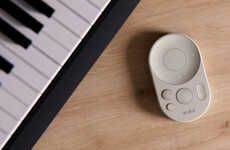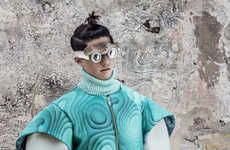
This Cyborg Teaches You to Play Color as Opposed to Sheet Music
Itai Buenahora — March 29, 2014 — Tech
References: play.google & wired
The music-teaching cyborgs that made the first color-conducted concert possible are here. Neil Harbisson was born with a condition called chromatopsia, which left him completely color-blind. He doesn't see colors -- he listens to them. The Spain-born artist can be seen wearing a discordant array of notes, arguing he dresses to sound good, not to look good. For the past decade, he has been wearing an 'eyeborg,' which transforms his grayscale vision into a world of color.
The device is a camera that captures colors and converts them into frequencies that the musician listens to via bone conduction. He "listens" to Warhols, paints with sounds and writes his music based off his visual surroundings.
His idea was to conduct a concert and teach musicians to play music based on colors, not on notes, and successfully conducted the first ever color-conducted concert. The initiative stretches out to all music enthusiasts, with an Eyeborg app being available worldwide, enabling other musicians to explore the beautiful world of color-conducted music.
The device is a camera that captures colors and converts them into frequencies that the musician listens to via bone conduction. He "listens" to Warhols, paints with sounds and writes his music based off his visual surroundings.
His idea was to conduct a concert and teach musicians to play music based on colors, not on notes, and successfully conducted the first ever color-conducted concert. The initiative stretches out to all music enthusiasts, with an Eyeborg app being available worldwide, enabling other musicians to explore the beautiful world of color-conducted music.
Trend Themes
1. Color-conducted Music - Disruptive innovation opportunity: Develop new instruments and music education methods that utilize colors as a way to compose and play music.
2. Wearable Technology for Music - Disruptive innovation opportunity: Invent wearable devices that enable musicians to experience music through different senses.
3. Augmented Music Perception - Disruptive innovation opportunity: Create technologies that enhance the way people perceive and interact with music through sensory augmentation.
Industry Implications
1. Music Education - Disruptive innovation opportunity: Incorporate color-based music instruction into traditional music education programs.
2. Wearable Technology - Disruptive innovation opportunity: Develop wearable devices that enhance the musical experience for both musicians and music enthusiasts.
3. Augmented Reality - Disruptive innovation opportunity: Integrate augmented reality technology into music platforms to provide a more immersive and multi-sensory music experience.
3.1
Score
Popularity
Activity
Freshness























